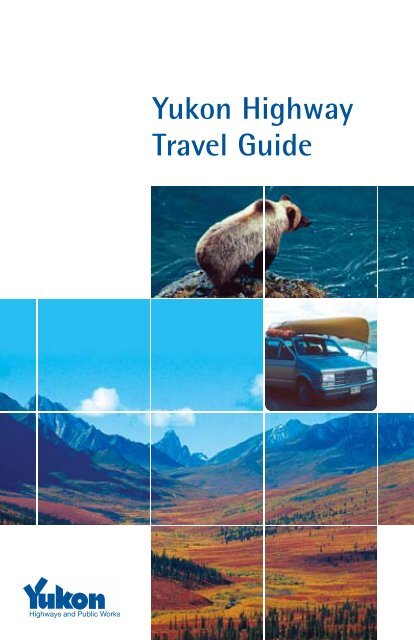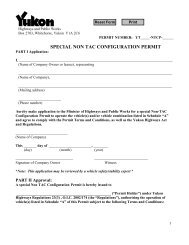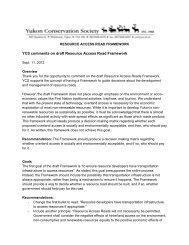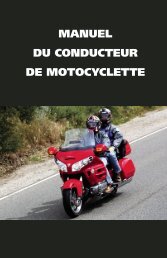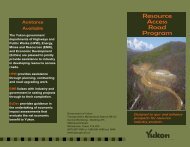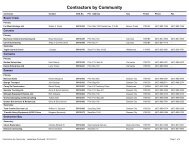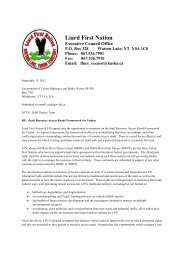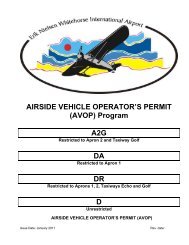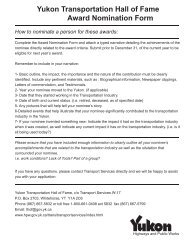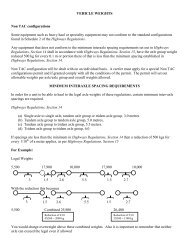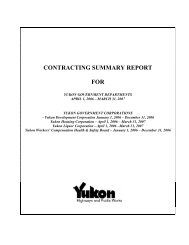Yukon Highway Travel Guide - Highways and Public Works
Yukon Highway Travel Guide - Highways and Public Works
Yukon Highway Travel Guide - Highways and Public Works
You also want an ePaper? Increase the reach of your titles
YUMPU automatically turns print PDFs into web optimized ePapers that Google loves.
<strong>Yukon</strong> <strong>Highway</strong><strong>Travel</strong> <strong>Guide</strong>
The <strong>Yukon</strong> is a very large territory. In many instances, communities are farapart, so road help could be some distance from the location of a vehiclebreakdown. Here are a few things you should do to prepare your vehiclefor a summer trip.Check your vehicle thoroughly with particular attention to:• Tires – All of your tires, including the spare tire, should have plenty oforiginal tread <strong>and</strong> no bald spots. Make sure each tire is inflated to thesame pressure, as well as balanced <strong>and</strong> aligned. You should alsoensure you have all of the tire-changing tools for your vehicle as well asa good-quality spare tire. Inspect your tires carefully <strong>and</strong> check fordamage <strong>and</strong> wear. Replace tires with bumps, bulges, deep cuts <strong>and</strong>exposed cord.3If you plan to travel for long distances <strong>and</strong> through unpopulated areas,invest in a full-sized spare tire. The small spare tires that come withmany vehicles are not meant to travel for more than about 80kilometres (approximately 50 miles) or at highway speeds.Attention to your tires will help with fuel consumption <strong>and</strong> vehicleh<strong>and</strong>ling in addition to being a key aid if you need to stop quickly oryou start to slide. Tires are safety devices, <strong>and</strong> the state of yourvehicle’s tires will affect how you stop in various road conditions.Summer travelThe <strong>Yukon</strong> is a popular summer destination for vacationers, foreign visitors<strong>and</strong> motorists who enjoy spectacular scenery, wildlife <strong>and</strong> the marvellousGold Rush history of this corner of North America.If you are planning to travel the spectacular Dempster <strong>Highway</strong> to theArctic Circle or on to Inuvik on the MacKenzie Delta, pay particularMany <strong>Yukon</strong>ers also eagerly look forward to the spring <strong>and</strong> summer tohead out to cabins <strong>and</strong> favourite recreation areas.2As the roads become busier <strong>and</strong> the days longer, summer travellersshould be well equipped for longer drives <strong>and</strong> mindful of others who arealso heading out to enjoy the season. While the <strong>Yukon</strong>’s main roads <strong>and</strong>many of the secondary routes are paved <strong>and</strong> maintained, travellersplanning to head off the beaten track or up to the Arctic Circle should payparticular attention to vehicle preparations.A little advance preparation will go a long way towards ensuring you havea safe <strong>and</strong> memorable holiday wherever it takes you in the <strong>Yukon</strong>.
4attention to your tires. The Dempster <strong>Highway</strong> is a year-round road, butit can be rugged <strong>and</strong> unforgiving in some sections. Asphalt- <strong>and</strong>pavement-grade tires (commonly known as four-ply) <strong>and</strong> tires with worntread will not withst<strong>and</strong> the rigours of the Dempster <strong>Highway</strong>. Motoristsplanning to travel the route should invest in six- or eight-ply tires.RV drivers should keep their vehicle weight down by emptying theirgrey water before travelling the highway <strong>and</strong> taking only the water theywill need. Unnecessary extra weight is hard on the tires <strong>and</strong> reducesfuel efficiency.• Fluids – Keeping your vehicle’s fluids at the recommended levels willhelp maintain your engine’s performance, especially during hot weather.Make sure your coolant is topped up, your radiator is working properly<strong>and</strong> all hoses <strong>and</strong> belts are in good repair. Although most servicecentres check fluid levels as part of regular service, you may wish toalso check your break, transmission <strong>and</strong> battery fluids before you leaveon a long drive.Roadwork takes place across the <strong>Yukon</strong> during the spring <strong>and</strong> summerseason, so it’s also important to fill up your windshield washer fluid <strong>and</strong>replace windshield wipers that streak the windshield. Keeping yourwindshield free of dust, dirt <strong>and</strong> summer bugs will help you enjoy asafer <strong>and</strong> more scenic drive.• Lights – Walk around your vehicle, <strong>and</strong> inspect <strong>and</strong> test all of yourlights. Ensure your light covers are intact, <strong>and</strong> replace any broken orburned-out bulbs. If light covers become covered with dirt as youtravel, ensure you clean them so that your lights will operate <strong>and</strong> beseen as intended. Seeing <strong>and</strong> being seen are critical to road safety,particularly in situations with reduced visibility.The use of daytime running lights (lower-powered headlights) is requiredin the <strong>Yukon</strong>. Since late 1989, vehicles produced in Canada areequipped with daytime lights, but many US-produced vehicles are not.If your vehicle is not equipped with daytime lights, be sure to activateyour headlights while driving in the territory. It’s the law.• Supplies – It’s a good idea to carry a few spare supplies such as yourvehicle’s type of oil, coolant, window cleaner <strong>and</strong> other fluids in theevent vehicle levels decline unexpectedly. A useful vehicle kit shouldalso contain a flashlight, paper towels, fresh drinking water, a blanket<strong>and</strong> a first aid kit. You may want to prepare your own kit or considerone of the professionally assembled units as a helpful addition to yourvehicle, regardless of your travel plans.• Secure loads – Many summer visitors <strong>and</strong> local residents travel theterritory with boats, camping gear <strong>and</strong> assorted sporting supplies. Ifyou’re loading up all of your gear, ensure nothing blocks your view <strong>and</strong>take extra care to carefully secure <strong>and</strong> tie down everything in your load.You won’t want to lose your recreation or camping supplies, <strong>and</strong>anything that comes loose could seriously harm another vehicle.5• Passing vehicles – If you see something you’d like to enjoy a littlelonger, if you’re having trouble finding a turnoff or location, or if you feellike taking it a little more slowly, pull safely off the road <strong>and</strong> let othervehicles continue on. Be mindful of vehicles bunching up behind you<strong>and</strong> take a moment to let them pass. You will reduce your progress toyour destination only by moments, <strong>and</strong> you will help prevent driversbehind you from taking risks to pass your vehicle. Having considerationfor other motorists will make the summer driving experience moreenjoyable <strong>and</strong> safer for everyone.
6• Fatigue – Every year, lives are lost when motorists fall asleep at thewheel. If you have been driving for an extended period, which is easy todo in the north because of the long hours of daylight (almost 24 hoursin some northern locations), stop <strong>and</strong> take a break. A beautiful warmday, a vehicle that’s toasty warm, a nice big lunch or many hours ofdriving can all contribute to your becoming drowsy behind the wheel. Ifyou are able, switch drivers often to reduce the risk of fatigue. Be alert<strong>and</strong> stop for a rest if you feel drowsy or increasingly tired.• Seat belts – Seat belt use is m<strong>and</strong>atory in the <strong>Yukon</strong>, so be sure you<strong>and</strong> all of the people in your vehicle buckle up. The proper use of seatbelts <strong>and</strong> child car seats is the single most effective way to reducevehicle-related injuries <strong>and</strong> fatalities. <strong>Yukon</strong> Royal Canadian MountedPolice (RCMP) conduct r<strong>and</strong>om road checks to check on seatbelt use,so obey the law <strong>and</strong> have a safe journey.• Impaired driving – <strong>Yukon</strong> police are also on the lookout for motoristsimpaired by alcohol, drugs or fatigue. If a police officer believes a driveris impaired by alcohol or drugs, the officer may do one or all of thefollowing:g Impound a vehicle for 30 or 60 days, perhaps even longer if thedriver has a prior conviction for an alcohol-related driving offence.g Suspend <strong>and</strong> confiscate the driver’s licence for 24 hours.g Suspend <strong>and</strong> confiscate the driver’s licence for 90 days.g Charge the driver with the crime of impaired driving. Visitors aretreated with respect <strong>and</strong> due process, but there is no specialdispensation for visitors to the territory.Road constructionThe <strong>Yukon</strong>’s winter weather can be very hard on roads <strong>and</strong> highways.The spring <strong>and</strong> summer seasons are short in the <strong>Yukon</strong>, so road crewshave a limited time to maintain <strong>and</strong> upgrade roads <strong>and</strong> highways. Whileroutes are passable <strong>and</strong> summer travel is eagerly encouraged, motoristsmay experience periodic <strong>and</strong> intermittent delays in some locations.Before heading out each day, you can check the regularly updated roadreports by calling 867-456-7623 or, toll free in the <strong>Yukon</strong>, 1-877-456-7623. These reports include updated information on construction areas,locations where you may experience delays <strong>and</strong> the general condition ofmost main roads. Reports are also available on the Internet atwww.gov.yk.ca/roadreport/.It’s important to use great care when travelling through a constructionzone. Here are helpful tips to remember:• Slow down <strong>and</strong> obey all flag persons <strong>and</strong> traffic personnel. Traffic controlstaff <strong>and</strong> flag persons are on construction sites to help provide a safeenvironment for both the on-site workers <strong>and</strong> the travelling public.• If you encounter a gravel section of road, slow down. <strong>Travel</strong>ling tooquickly through a gravel zone can cause you to lose control of yourvehicle, <strong>and</strong> it can throw up rocks <strong>and</strong> dust that can seriously impairvisibility, harm your vehicle <strong>and</strong> damage other vehicles on the road.7
Here are a few winter tips to help you have a safer winter journey:• Ensure your vehicle is in top condition for winter. A good maintenancecheck will provide you with a level of assurance that your vehicle willstart <strong>and</strong> run when you need it.• Cold weather thickens most lubricants, so take care to ensure yourvehicle’s liquids are rated for winter use <strong>and</strong> maintained at therecommended level.98Winter drivingWinter can be a very beautiful but harsh time in the north. Weather acrossthe north can change unexpectedly <strong>and</strong> dramatically.Winter is by far the hardest season on your vehicle, so fall investments incare <strong>and</strong> maintenance may help you avoid substantial winter repair billslater on. Be sure your vehicle is in good repair before setting out on awinter journey.Drivers should also take a few minutes to check the weather forecast <strong>and</strong>road conditions through the Department of <strong>Highway</strong>s <strong>and</strong> <strong>Public</strong> <strong>Works</strong>’road report. (Contact information is provided at the end of this booklet.)Department of <strong>Highway</strong>s <strong>and</strong> <strong>Public</strong> <strong>Works</strong> staff vigilantly maintain most<strong>Yukon</strong> roads, but the weather can change suddenly, creating difficult <strong>and</strong>,at times, very hazardous conditions.It is always important to match your speed to the road conditions <strong>and</strong> toremember that posted speed limits are for driving under optimumconditions. <strong>Yukon</strong> weather can be highly changeable <strong>and</strong> appear to movethrough all four seasons within one day! Adjusting your driving speed tothe road <strong>and</strong> weather conditions will help maintain your safety.• Make sure your:g Battery is strong.g Visibility <strong>and</strong> signal lights are all operating <strong>and</strong> their covers are clear<strong>and</strong> unbroken.g Heater <strong>and</strong> defroster are working well.g Oil <strong>and</strong> antifreeze are tested <strong>and</strong> have the appropriate rating for theseason.g Windshield washer fluid is rated to -40° or lower.• Tires – Good tires are critical to safe winter driving. Your vehicle’straction with the road will determine how your car h<strong>and</strong>les, stops,starts, turns or skids.Air pressure decreases in colder weather, so check your tires <strong>and</strong> makesure they are inflated to the recommended level. All of your tires shouldhave the same tread pattern for maximum traction.If you travel in areas with a great deal of snow, you may want toconsider a different type of all-season or winter tire versus the kind youmight want to have for predominantly icy or wet conditions. A tirespecialist can advise you on the appropriate tires for your specificvehicle <strong>and</strong> typical driving conditions.• Windshields <strong>and</strong> wipers – Driving during snowy conditions can beextremely difficult <strong>and</strong> even more so if snow or ice accumulates on yourwindshield. Before you drive, make sure you clean all the snow off your
vehicle so it doesn’t cover the headlights, accumulate around thewindshield as you drive, or fly onto vehicles following behind.It’s also important to wait until your defrost system heats up so that itcan clear your windows of ice <strong>and</strong> fog as well as help keep them clearas you start your drive.Ensure your windshield washer fluid is topped up <strong>and</strong> rated to at least-40°. Most washer fluids do not melt heavy ice, although some br<strong>and</strong>swill aid in the melting process.If your windshield becomes too clogged with ice or snow, or roadvisibility declines, carefully pull over in a safe location as soon as youcan. Proceed only when visibility improves <strong>and</strong> you can see the road<strong>and</strong> other vehicles clearly.• Driver preparation – The key to a safe trip during the winter ispreparation—taking the necessary time to get to your destination <strong>and</strong>,if conditions are poor, assessing frankly whether the journey is trulynecessary.Check the weather report <strong>and</strong> road conditions before you depart,ensure you have plenty of fuel in your vehicle <strong>and</strong> plan your travel withsafety in mind. Let someone know your travel plans, including yourdestination, intended route <strong>and</strong> projected arrival time.The Canadian Automobile Association recommends you keep thefollowing items in the trunk of your car for winter travel.g shovelg s<strong>and</strong>, salt or kitty litterg traction matsg tow chain or sturdy ropeg compassg cloth or roll of paper towelsg warning light or road flaresg extra clothing <strong>and</strong> footwearg emergency food packg axe or hatchetg booster cablesg roll of duct tape to repair hose leaks <strong>and</strong> assorted other problemsg selection of small tools such as pliers, a multi-head screwdriver,a wrench or two etc.g ice scraper <strong>and</strong> brushg matches <strong>and</strong> a survival c<strong>and</strong>le in a deep can to warm h<strong>and</strong>s,heat a drink or use as an emergency lightg fire extinguisherg methyl hydrate for fuel line <strong>and</strong> windshield de-icing1110Road <strong>and</strong> driving conditions can change very quickly in the <strong>Yukon</strong>.In addition, what may look like a clear road can in fact be a surfaceinconspicuously dotted with black ice.Sudden <strong>and</strong> heavy snow, freezing rain, ice fog, winds <strong>and</strong> severetemperatures are all changes northern drivers can face during thecourse of a winter journey.
12You should consider keeping these items in the cab of your vehicle:g road mapsg flashlightg first aid kitg coins for public phonesg blanket (special survival blankets are best)g any medications you take regularly during the dayg if your vehicle has power locks <strong>and</strong> windows, a small hammer. (If yourcar looses power with the doors <strong>and</strong> windows closed <strong>and</strong> locked,you won’t be able to get out. Using extreme care, you may need tobreak a window to exit the vehicle in an emergency situation.)• If you are stuck or str<strong>and</strong>ed – The Canadian Automobile Association<strong>and</strong> federal emergency agencies offer the following advice if you arecaught in a storm or stuck in the snow:g Don’t panic. Stay in your car so that you have shelter <strong>and</strong> don’tbecome lost. Avoid overexertion <strong>and</strong> panic <strong>and</strong> wait for help to arrive.g If you attempt to free your vehicle from the snow, dress warmly <strong>and</strong>take particular care to shovel slowly. Try to keep as dry as possible.Wet clothing from weather or perspiration can dramatically reduceyour body temperature. Shovelling <strong>and</strong> bitter cold can kill, so be verycareful how you attempt to free your vehicle body temperature.Shovelling <strong>and</strong> bitter cold can kill, so be very careful how youattempt to free your vehicle.g Keep fresh air in your vehicle by opening a window on the sidesheltered from the wind. Run your motor sparingly, but before youdo, ensure the vehicle’s exhaust pipe is not blocked by snow or anyobstruction. If you run your vehicle often, lethal exhaust fumes(carbon monoxide) may accumulate, so take particular care with theuse of the engine <strong>and</strong> ensure the tail pipe has not become blockedby drifting snow.g If possible, use an emergency c<strong>and</strong>le for heat instead of the vehicleheater. To help stay warm, put on a hat. An estimated 60 percent ofour body heat is lost through our heads.g Set out a warning light or flares <strong>and</strong> use the interior car lights ratherthan the headlights. Overuse of the headlights may run downyour battery.g Exercise your limbs vigorously, try to keep moving, <strong>and</strong> keep aneye out for traffic or searchers. Try to stay awake. If you fall asleep,your body temperature will decline <strong>and</strong> you may place yourself atincreased risk from the cold. Try to remain awake as muchas possible.13
14WildlifeThe <strong>Yukon</strong>’s wildlife is wonderful to observe. A small red fox peekingout from the side of the road, a bear roaming through the bush, aptarmigan blending beautifully with the snow, or a moose browsingin a marshy area are all exciting to see <strong>and</strong> fascinating to watch,often serving as the highlight of a drive.If you are particularly eager to see wildlife, the best times during thespring <strong>and</strong> summer are early in the morning, late evening <strong>and</strong>through the night. These are also the times when animals tend to beon the road, so it’s important to be especially vigilant.During the winter, with reduced daylight <strong>and</strong>, at times, visibility,animals can be particularly hard to see. Motorists should take careto reduce their speed on highways <strong>and</strong> to be especially alert towildlife. Some drivers may wish to avoid travelling in the dark.Vehicles <strong>and</strong> animals can be a very dangerous mix. A collision with an animalcan be extremely upsetting as well as damaging. Even small animals c<strong>and</strong>amage a vehicle, while large ones can cause more extensive damage <strong>and</strong>,in some instances, cause injury or death for motorists as well as the animals.Here are a few suggestions to help you can maximize your enjoyment of<strong>Yukon</strong> wildlife while avoiding harm to yourself, your passengers or yourvehicle:• Be particularly careful during the times of day when animals are usuallyspotted on or close to the road. In spring <strong>and</strong> summer, early mornings,late evenings <strong>and</strong> through the night are typical times to see wildlife. Inwinter, animals can be on the road at any time.• Watch for roadside signs warning of animals. These notices are postedin areas where wildlife is repeatedly observed near or on the road.• If you see one animal, chances are there will be others close by. Manyanimals travel in groups, so watch for animals that may be following.Slow down <strong>and</strong> pass carefully through the area.• Some animals may become spooked or frightened if you encounter themon the road. Moose, for example, will tend to stay on the road whilerunning away from your vehicle, which may pose a danger to oncomingor other motorists. If you encounter a moose on the right-of-way, eitherpull over safely or proceed very slowly until the animal leaves the road.15
16• If you see wildlife off the road or in the distance that you’d like to viewfor a little longer, ensure you pull well off to the side of the road in asafe location, or look for a designated rest stop or viewpoint along theroute. Enjoy wildlife from a safe distance, <strong>and</strong> even though they maylook appealing, remember that the “wild” in wildlife means unpredictable.Never underestimate an animal. Wildlife can become aggressive <strong>and</strong>dangerous suddenly, <strong>and</strong> some animals can move extremely fast.• Never feed or leave food available for wildlife, as you will endanger yourself<strong>and</strong> others <strong>and</strong>, possibly, contribute to the early death of the animal. Wildanimals that start to approach people are usually killed accidentally orintentionally. If you come into contact with wildife, be careful.Cell phonesIf you have a cell phone, you should note that service is limited toWhitehorse <strong>and</strong> its outskirts, so be sure you are well equipped forextended periods of driving between communities <strong>and</strong> phones.Have a safe journeyThe <strong>Yukon</strong> is a magnificent territory <strong>and</strong> one that will leave you withmemories to last a lifetime. If you decide to drive through thisnorthwestern section of Canada, bring plenty of film, prepare your vehicle<strong>and</strong> yourself, <strong>and</strong> have a wonderful, safe journey.More informationIf you would like up-to-date information on <strong>Yukon</strong> road conditions, visit uson the web at www.gov.yk.ca/roadreport/.You can also call our pre-recorded phone line at 867-456-7623 or, fromwithin the <strong>Yukon</strong>, toll free at 1-877-456-7623.


